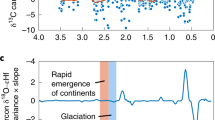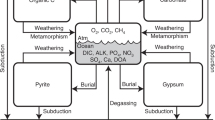Abstract
Earth owes its oxygenated atmosphere to its unique claim on life, but how the atmosphere evolved from an initially oxygen-free state remains unresolved. The rise of atmospheric oxygen occurred in two stages: approximately 2.5 to 2.0 billion years ago during the Great Oxidation Event and roughly 2 billion years later during the Neoproterozoic Oxygenation Event. We propose that the formation of continents about 2.7 to 2.5 billion years ago, perhaps due to the initiation of plate tectonics, may have led to oxygenation by the following mechanisms. In the first stage, the change in composition of Earth's crust from iron- and magnesium-rich mafic rocks to feldspar- and quartz-rich felsic rocks could have caused a decrease in the oxidative efficiency of the Earth's surface, allowing atmospheric O2 to rise. Over the next billion years, as carbon steadily accumulated on the continents, metamorphic and magmatic reactions within this growing continental carbon reservoir facilitated a gradual increase in the total long-term input of CO2 to the ocean–atmosphere system. Given that O2 is produced during organic carbon burial, the increased CO2 input may have triggered a second rise in O2. A two-step rise in atmospheric O2 may therefore be a natural consequence of plate tectonics, continent formation and the growth of a crustal carbon reservoir.
This is a preview of subscription content, access via your institution
Access options
Subscribe to this journal
Receive 12 print issues and online access
$259.00 per year
only $21.58 per issue
Buy this article
- Purchase on Springer Link
- Instant access to full article PDF
Prices may be subject to local taxes which are calculated during checkout





Similar content being viewed by others
References
Lyons, T. W., Reinhard, C. T. & Planavsky, N. J. The rise of oxygen in Earth's early ocean and atmosphere. Nature 506, 307–315 (2014).
Farquhar, J. & Wing, B. A. Multiple sulfur isotopes and the evolution of the atmosphere. Earth Planet. Sci. Lett. 213, 1–13 (2003).
Kump, L. R., Kasting, J. F. & Barley, M. E. Rise of atmospheric oxygen and the “upside-down” Archean mantle. Geochem. Geophys. Geosyst. 2, 2000GC000114 (2001).
Kasting, J. F., Eggler, D. H. & Raeburn, S. P. Mantle redox evolution and the oxidation state of the Archean atmosphere. J. Geol. 101, 245–257 (1993).
Canfield, D. E. The early history of atmospheric oxygen: homage to Robert M. Garrels. Annu. Rev. Earth Planet. Sci. 33, 1–36 (2005).
Kanzaki, Y. & Murakami, T. Estimates of atmospheric O2 in the Paleoproterozoic from paleosols. Geochim. Cosmochim. Acta 174, 263–290 (2016).
Berner, R. A. The Phanerozoic Carbon Cycle: CO2 and O2 (Oxford Univ. Press, 2004).
Planavsky, N. J. et al. Evidence for oxygenic photosynthesis half a billion years before the Great Oxidation Event. Nature Geosci. 7, 283–286 (2014).
Anbar, A. D. et al. A whiff of oxygen before the great oxidation event? Science 317, 1903–1906 (2007).
David, L. A. & Alm, E. J. Rapid evolutionary innovation during an Archaean genetic expansion. Nature 469, 93–96 (2011).
Crowe, S. A. et al. Atmospheric oxygenation three billion years ago. Nature 501, 535–538 (2013).
Laakso, T. A. & Schrag, D. P. Regulation of atmospheric oxygen during the Proterozoic. Earth Planet. Sci. Lett. 388, 81–91 (2014).
Catling, D. C. & Claire, M. W. How Earth's atmosphere evolved to an oxic state: a status report. Earth Planet. Sci. Lett. 237, 1–20 (2005).
Catling, D. C., Zahnle, K. J. & Mckay, C. P. Biogenic methane, hydrogen escape, and the irreversible oxidation of early Earth. Science 293, 839–843 (2001).
Gaillard, F., Scaillet, B. & Arndt, N. T. Atmospheric oxygenation caused by a change in volcanic degassing pressure. Nature 478, 229–232 (2011).
Li, Z.-X. A. & Lee, C.-T. A. The constancy of upper mantle fO2 through time inferred from V/Sc ratios in basalts. Earth Planet. Sci. Lett. 228, 483–493 (2004).
Canil, D. Vanadium partitioning and the oxidation state of Archaean komatiite magmas. Nature 389, 842–845 (1997).
Lee, C.-T. A., Thurner, S., Paterson, S. R. & Cao, W. The rise and fall of continental arcs: interplays between magmatism, uplift, weathering and climate. Earth Planet. Sci. Lett. 425, 105–119 (2015).
Voice, P. J., Kowalewski, M. & Eriksson, K. A. Quantifying the timing and rate of crustal evolution: global compilation of radiometrically dated detrital zircon grains. J. Geol. 119, 109–126 (2011).
Dhuime, B., Hawkesworth, C. J., Cawood, P. A. & Storey, C. D. A change in the geodynamics of continental growth 3 billion years ago. Science 335, 1334–1336 (2012).
McKenzie, N. R., Horton, B. K., Loomis, S. E., Stockli, D. F. & Lee, C.-T. A. Continental arc volcanism as the principal driver of icehouse-greenhouse variability. Science 352, 444–447 (2016).
McCulloch, M. T. & Bennett, V. C. Progressive growth of the Earth's continental crust and depleted mantle; geochemical constraints. Geochim. Cosmochim. Acta 58, 4717–4738 (1994).
Cawood, P. A., Hawkesworth, C. J. & Dhuime, B. The continental record and the generation of continental crust. Geol. Soc. Am. Bull. 125, 14–32 (2012).
McKenzie, N. R., Hughes, N. C., Gill, B. C. & Myrow, P. M. Plate tectonic influences on Neoproterozoic-early Paleozoic climate and animal evolution. Geology 42, 127–130 (2014).
Watson, E. B. & Harrison, T. M. Zircon saturation revisited: temperature and composition effects in a variety of crustal magma types. Earth Planet. Sci. Lett. 64, 295–304 (1983).
Keller, C. B. & Schoene, B. Statistical geochemistry reveals disruption in secular lithospheric evolution about 2.5 Gyr ago. Nature 485, 490–493 (2012).
Dhuime, B., Wuestefeld, A. & Hawkesworth, C. J. Emergence of modern continental crust about 3 billion years ago. Nature Geosci. 8, 552–555 (2015).
Taylor, S. R. & McLennan, S. M. The Continental Crust: Its Composition and Evolution (Blackwell, 1985).
Tang, M., Chen, K. & Rudnick, R. L. Archean upper crust transition from mafic to felsic marks the onset of plate tectonics. Science 351, 372–375 (2016).
Lee, C.-T. A. & Morton, D. M. High silica granites: terminal porosity and crystal settling. Earth Planet. Sci. Lett. 409, 23–31 (2015).
Lee, C.-T. A., Morton, D. M., Farner, M. J. & Moitra, P. Field and model constraints on silicic melt segregation by compaction/hindered settling: the role of water and its effect on latent heat release. Am. Mineral. 100, 1762–1777 (2015).
Weller, M. B., Lenardic, A. & O'Neill, C. The effects of internal heating and large scale variations on tectonic bi-stability in terrestrial planets. Earth Planet. Sci. Lett. 420, 85–94 (2015).
Jenner, F. E. & O'Neill, H. S. C. Analysis of 60 elements in 616 ocean floor basaltic glasses. Geochem. Geophys. Geosyst. 13, Q02005 (2012).
Kress, V. C. & Carmichael, I. S. E. The compressibility of silicate liquids containing Fe2O3 and the effect of composition, temperature, oxygen fugacity and pressure on their redox states. Contrib. Mineral. Petrol. 108, 82–92 (1991).
Lee, C.-T. A. et al. The redox state of arc mantle using Zn/Fe systematics. Nature 468, 681–685 (2010).
Li, C. & Ripley, E. M. Sulfur contents at sulfide-liquid or anhydrite saturation in silicate melts: empirical equations and example applications. Econ. Geol. 104, 405–412 (2009).
Lee, C.-T. A. et al. Copper systematics in arc magmas and implications for crust-mantle differentiation. Science 336, 64–68 (2012).
Kasting, J. F. Earth's early atmosphere. Science 259, 920–926 (1993).
Planavsky, N. J. et al. Low mid-Proterozoic atmospheric oxygen levels and the delayed rise of animals. Science 346, 635–638 (2014).
Goldblatt, C., Lenton, T. M. & Watson, A. J. Bistability of atmospheric oxygen and the Great Oxidation. Nature 443, 683–686 (2006).
Dasgupta, R. & Hirschmann, M. M. The deep carbon cycle and melting in Earth's interior. Earth Planet. Sci. Lett. 298, 1–13 (2010).
Walker, J. C. G., Hays, P. B. & Kasting, J. F. A negative feedback mechanism for the long-term stabilization of Earth's surface temperature. J. Geophys. Res. 86, 9776–9782 (1981).
Berner, R. A. & Caldeira, K. The need for mass balance and feedback in the geochemical carbon cycle. Geology 25, 955–956 (1997).
Hayes, J. M. & Waldbauer, J. R. The carbon cycle and associated redox processes through time. Phil. Trans. R. Soc. B 361, 931–950 (2006).
Lee, C.-T. A. et al. Continental arc-island arc fluctuations, growth of crustal carbonates and long-term climate change. Geosphere 9, 21–36 (2013).
Holland, H. D. Why the atmosphere became oxygenated. Geochim. Cosmochim. Acta 73, 5241–5255 (2009).
Lee, C.-T. A. & Lackey, J. S. Global continental arc flare-ups and their relation to long-term greenhouse conditions. Elements 11, 125–130 (2015).
Hanson, R. B. & Barton, M. D. Thermal development of low-pressure metamorphic belts: results from two-dimensional numerical models. J. Geophys. Res. 94, 10363–10377 (1989).
Holland, H. D. The Chemistry of the Atmosphere and Oceans Vol. 351 (John Wiley, 1978).
Kump, L. R. & Arthur, M. A. Interpreting carbon-isotope excursions: carbonates and organic matter. Chem. Geol. 161, 181–198 (1999).
Krissansen-Totton, J., Buick, R. & Catling, D. C. A statistical analysis of the carbon isotope record from the Archean to Phanerozoic and implications for the rise of oxygen. Am. J. Sci. 315, 275–316 (2015).
Kasting, J. F. Theoretical constraints on oxygen and carbon dioxide concentrations in the Precambrian atmosphere. Precambrian Res. 34, 205–229 (1987).
Sagan, C. & Mullen, G. Earth and Mars: evolution of atmospheres and surface temperatures. Science 177, 52–56 (1972).
Taijika, E. Faint young Sun and the carbon cycle: implication for the Proterozoic global glaciations. Earth Planet. Sci. Lett. 214, 443–453 (2003).
Kah, L. C. & Riding, R. Mesoproterozoic carbon dioxide levels inferred from calcified cyanobacteria. Geology 35, 799–802 (2007).
Sheldon, N. D. Precambrian paleosols and atmospheric CO2 levels. Precambrian Res. 147, 148–155 (2006).
Lee, C.-T. A. & Bachmann, O. How important is the role of crystal fractionation in making intermediate magmas? Insights from Zr and P systematics. Earth Planet. Sci. Lett. 393, 266–274 (2014).
Lee, C.-T. A., Morton, D. M., Kistler, R. W. & Baird, A. K. Petrology and tectonics of Phanerozoic continent formation: from island arcs to accretion and continental arc magmatism. Earth Planet. Sci. Lett. 263, 370–387 (2007).
Liu, Y., Samaha, N.-T. & Baker, D. R. Sulfur concentration at sulfide saturation (SCSS) in magmatic silicate melts. Geochem. Cosmochim. Acta 71, 1783–1799 (2007).
Burton, M. R., Sawyer, G. M. & Granieri, D. Deep carbon emissions from volcanoes. Rev. Mineral. Geochem. 75, 323–354 (2013).
Petsch, S. T. in Treatise of Geochemistry 2nd edn, Vol. 12 (eds Holland, H. & Turekian, K.) 217–238 (2014).
Acknowledgements
This work was supported by NSF Frontiers of Earth Systems Dynamics grant OCE-1338842. Discussions with B. Dyer, R. Dasgupta, B. Shen, N. Planavsky, C. Reinhard and the 'CIA' (continental-island arc) working group are appreciated.
Author information
Authors and Affiliations
Contributions
C.-T. A. L. conceived the idea, developed the models and wrote the manuscript. L.Y.Y provided conceptual insight into box modelling and atmospheric chemistry. N.R.M provided insight into zircon data and general geology. Y.Y. and K.O. provided insight into global carbon cycle modelling. A.L. provided insight into mantle dynamics. All authors contributed to editing the manuscript and validating the models.
Corresponding author
Ethics declarations
Competing interests
The authors declare no competing financial interests.
Rights and permissions
About this article
Cite this article
Lee, CT., Yeung, L., McKenzie, N. et al. Two-step rise of atmospheric oxygen linked to the growth of continents. Nature Geosci 9, 417–424 (2016). https://doi.org/10.1038/ngeo2707
Received:
Accepted:
Published:
Issue Date:
DOI: https://doi.org/10.1038/ngeo2707
This article is cited by
-
Sub-arc mantle fugacity shifted by sediment recycling across the Great Oxidation Event
Nature Geoscience (2023)
-
Atmosphere-altered sediments were recycled into the mantle across the Great Oxidation Event
Nature Geoscience (2023)
-
Plate Tectonics: The Stabilizer of Earth’s Habitability
Journal of Earth Science (2023)
-
The influence of Tethyan evolution on changes of the Earth’s past environment
Science China Earth Sciences (2023)
-
Plant fingerprints in the deep Earth
Nature Geoscience (2022)



